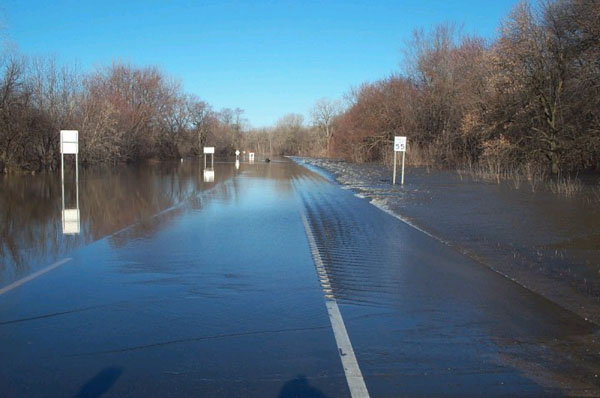By Bob Filipczak

(Pictured above) Water from the spring floods of 2010 covers Hwy 93 in LeSueur. File photo by David Gonzalez
|
By many accounts, spring 2011 may be a high-water mark for flooding in Minnesota. Newsline recently caught up with employees from six Mn/DOT districts to see how they are preparing for what could be unprecedented flooding.
District 2
Curt Larson, District 2 Maintenance superintendent, is in charge of flood preparations for a district that includes the Red River and Wild Rice River.
Larson said he anticipates they will need to set up a temporary levee system in East Grand Forks to keep the Hwy 2 Kennedy Bridge open.
Because flooding is a rule rather than an exception in District 4, Larson said they have been doing a lot to prevent flood damage to roads, including using integrated concrete materials to help stabilize slopes.
District 4
Dana Hanson, District 4 Public Affairs, said her district faces a lot of overland flooding that could close many sections of road, resulting in extensive detours that constantly change as waters rise. District 4 monitors all bridges in the district, in particular the Interstate 94 bridge and Hwy 10 bridge over the Red River between Fargo and Moorhead.
District 4 also is anticipating construction of three separate dikes for a stretch of Hwy 210 about six miles east of Breckenridge.
Predictions for unprecedented flooding this spring do not ruffle Hanson too much.
“This year we are even more prepared,” Hanson said. “The cities and the counties are more prepared as well—so I believe even if the flooding is a little worse, our preparation should make up for it.”
Metro District
Jim Michael, Metro District transportation operations supervisor, and Bev Farraher, Metro District Maintenance engineer, are in charge of Metro District’s flood preparations. Michael and Farraher said they think this season will be more intense due to fast thawing and huge snowfalls, so they are making sure materials needed to respond quickly to flooding are in place, including plans and paperwork.
A couple of things the district is looking at in preparation for the floods is restriping Hwy 169 so it can handle more traffic when Hwy 41 and Hwy 101 are closed and a possible temporary traffic signal on Hwy 25 near Belle Plaine to improve traffic flow.
“It’s all under discussion about how to make it work right, make it work safely and make sure it works with the city’s needs,” Farraher said.
District 6
Craig Falkum, District 6 Bridge Office, joked that in preparation for this year’s floods, he has tied up a canoe outside his office.
Although Falkum’s team has had a lot of experience with floods, he is anticipating that this spring could throw him a few curveballs, including the possibility of seeing flooding in areas that typically don’t cause problems.
Falkum has about a dozen bridges he monitors for scour, which happens when water begins to erode the bottom of a channel, exposing the bridge’s piers and abutments. When the water gets to a certain height, the team monitors bridges that might experience scour using sonar and dropped weights.
“We’ve had some experience with flooding before and we think we understand where it’s going to go, but we are monitoring it because we don’t know the exact locations,” Falkum said. “This may be of a magnitude greater than we’ve ever seen before so we are being watchful and wary.”
District 7
Gordon Regenscheid, Assistant District Engineer, is overseeing preparations in District 7, which had two substantial floods in 2010. Regenscheid and his team are going over a lot of what-if situations based on last year’s experiences. He is also looking at getting some sand and plastic together for worm dikes— low barriers designed for water that’s only about a foot deep.
“It’s a fast way to keep a road open,” Regenscheid said.
Communicating road closures is key, according to Regenscheid, who called Mn/DOT’s 511 system the “backbone” when it comes to flood-related efforts.
District 8
Jeff Butson, District 8 Maintenance superintendent, is leading preparation efforts for District 8 and is working to set up the District Emergency Operations Center, which he said he thinks will be operational the week of March 21.
Butson said the district is planning to close Hwy 212 near Montevideo for a short time so the United States Army Corps of Engineers can construct a dike before the road floods. |



